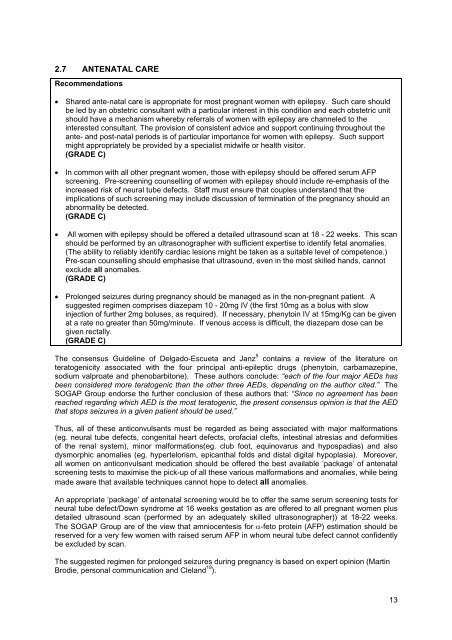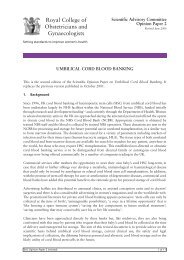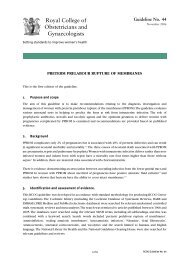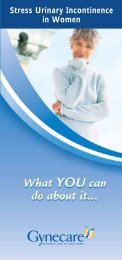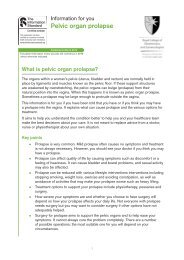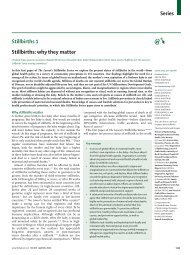The Management of Pregnancy in Women with ... - Dr Paul P Fogarty
The Management of Pregnancy in Women with ... - Dr Paul P Fogarty
The Management of Pregnancy in Women with ... - Dr Paul P Fogarty
You also want an ePaper? Increase the reach of your titles
YUMPU automatically turns print PDFs into web optimized ePapers that Google loves.
2.7 ANTENATAL CARE<br />
Recommendations<br />
• Shared ante-natal care is appropriate for most pregnant women <strong>with</strong> epilepsy. Such care should<br />
be led by an obstetric consultant <strong>with</strong> a particular <strong>in</strong>terest <strong>in</strong> this condition and each obstetric unit<br />
should have a mechanism whereby referrals <strong>of</strong> women <strong>with</strong> epilepsy are channeled to the<br />
<strong>in</strong>terested consultant. <strong>The</strong> provision <strong>of</strong> consistent advice and support cont<strong>in</strong>u<strong>in</strong>g throughout the<br />
ante- and post-natal periods is <strong>of</strong> particular importance for women <strong>with</strong> epilepsy. Such support<br />
might appropriately be provided by a specialist midwife or health visitor.<br />
(GRADE C)<br />
• In common <strong>with</strong> all other pregnant women, those <strong>with</strong> epilepsy should be <strong>of</strong>fered serum AFP<br />
screen<strong>in</strong>g. Pre-screen<strong>in</strong>g counsell<strong>in</strong>g <strong>of</strong> women <strong>with</strong> epilepsy should <strong>in</strong>clude re-emphasis <strong>of</strong> the<br />
<strong>in</strong>creased risk <strong>of</strong> neural tube defects. Staff must ensure that couples understand that the<br />
implications <strong>of</strong> such screen<strong>in</strong>g may <strong>in</strong>clude discussion <strong>of</strong> term<strong>in</strong>ation <strong>of</strong> the pregnancy should an<br />
abnormality be detected.<br />
(GRADE C)<br />
• All women <strong>with</strong> epilepsy should be <strong>of</strong>fered a detailed ultrasound scan at 18 - 22 weeks. This scan<br />
should be performed by an ultrasonographer <strong>with</strong> sufficient expertise to identify fetal anomalies.<br />
(<strong>The</strong> ability to reliably identify cardiac lesions might be taken as a suitable level <strong>of</strong> competence.)<br />
Pre-scan counsell<strong>in</strong>g should emphasise that ultrasound, even <strong>in</strong> the most skilled hands, cannot<br />
exclude all anomalies.<br />
(GRADE C)<br />
• Prolonged seizures dur<strong>in</strong>g pregnancy should be managed as <strong>in</strong> the non-pregnant patient. A<br />
suggested regimen comprises diazepam 10 - 20mg IV (the first 10mg as a bolus <strong>with</strong> slow<br />
<strong>in</strong>jection <strong>of</strong> further 2mg boluses, as required). If necessary, phenyto<strong>in</strong> IV at 15mg/Kg can be given<br />
at a rate no greater than 50mg/m<strong>in</strong>ute. If venous access is difficult, the diazepam dose can be<br />
given rectally.<br />
(GRADE C)<br />
<strong>The</strong> consensus Guidel<strong>in</strong>e <strong>of</strong> Delgado-Escueta and Janz 5 conta<strong>in</strong>s a review <strong>of</strong> the literature on<br />
teratogenicity associated <strong>with</strong> the four pr<strong>in</strong>cipal anti-epileptic drugs (phenyto<strong>in</strong>, carbamazep<strong>in</strong>e,<br />
sodium valproate and phenobarbitone). <strong>The</strong>se authors conclude: “each <strong>of</strong> the four major AEDs has<br />
been considered more teratogenic than the other three AEDs, depend<strong>in</strong>g on the author cited.” <strong>The</strong><br />
SOGAP Group endorse the further conclusion <strong>of</strong> these authors that: “S<strong>in</strong>ce no agreement has been<br />
reached regard<strong>in</strong>g which AED is the most teratogenic, the present consensus op<strong>in</strong>ion is that the AED<br />
that stops seizures <strong>in</strong> a given patient should be used.”<br />
Thus, all <strong>of</strong> these anticonvulsants must be regarded as be<strong>in</strong>g associated <strong>with</strong> major malformations<br />
(eg. neural tube defects, congenital heart defects, or<strong>of</strong>acial clefts, <strong>in</strong>test<strong>in</strong>al atresias and deformities<br />
<strong>of</strong> the renal system), m<strong>in</strong>or malformations(eg. club foot, equ<strong>in</strong>ovarus and hypospadias) and also<br />
dysmorphic anomalies (eg. hypertelorism, epicanthal folds and distal digital hypoplasia). Moreover,<br />
all women on anticonvulsant medication should be <strong>of</strong>fered the best available ‘package’ <strong>of</strong> antenatal<br />
screen<strong>in</strong>g tests to maximise the pick-up <strong>of</strong> all these various malformations and anomalies, while be<strong>in</strong>g<br />
made aware that available techniques cannot hope to detect all anomalies.<br />
An appropriate ‘package’ <strong>of</strong> antenatal screen<strong>in</strong>g would be to <strong>of</strong>fer the same serum screen<strong>in</strong>g tests for<br />
neural tube defect/Down syndrome at 16 weeks gestation as are <strong>of</strong>fered to all pregnant women plus<br />
detailed ultrasound scan (performed by an adequately skilled ultrasonographer)) at 18-22 weeks.<br />
<strong>The</strong> SOGAP Group are <strong>of</strong> the view that amniocentesis for α-feto prote<strong>in</strong> (AFP) estimation should be<br />
reserved for a very few women <strong>with</strong> raised serum AFP <strong>in</strong> whom neural tube defect cannot confidently<br />
be excluded by scan.<br />
<strong>The</strong> suggested regimen for prolonged seizures dur<strong>in</strong>g pregnancy is based on expert op<strong>in</strong>ion (Mart<strong>in</strong><br />
Brodie, personal communication and Cleland 19 ).<br />
13


